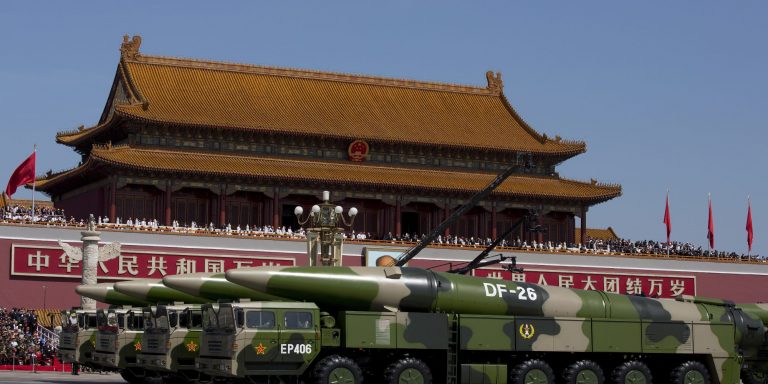INTELBRIEF
January 30, 2019
IntelBrief: Chinese Military Modernization and Implications for Taiwan

- Earlier this month, China released footage from a military exercise where the ‘Guam killer’ DF-26 ballistic missile was tested.
- In the 21st Century, China has increasingly focused resources on modernizing its military to match its economic power.
- Chinese military modernization presents the most significant challenge to U.S. hegemony and conventional warfighting dominance.
- Beyond comparing U.S. and Chinese military might, analysts fear that Beijing’s capabilities will be used to reunite Taiwan with the Chinese mainland by force.
.
Earlier this month, China tested the ‘Guam Killer,’ an intermediate-range ballistic missile with the capability to strike U.S. bases and vessels in the Pacific, immediately spurring debates about the potential for a Sino-American military showdown. China is spending an increasing amount of resources on modernizing and enhancing the capability of its military. Due to low levels of transparency, estimating China’s military spending proves hard, but figures from the SIPRI Military Expenditure Database show that over the last decade, China has increased its defense spending more than five-fold. The goal, according to Chinese president Xi Jinping, is to have a 'world-class force' by 2050.
Even with the People’s Liberation Army (PLA) being down-sized to 2 million troops, China still boasts the largest military in the world. Xi’s reforms are focused on transforming the Chinese military into a modern force with an advanced degree of readiness, both on land and in the maritime domain. China has taken significant steps in realizing that goal, especially by ramping up its naval power. Examples include: introducing the new J-20 stealth fighter jet, building its first aircraft carrier, and establishing its first overseas military base in Djibouti. The military modernizations have been coupled with increasing Chinese aggression abroad. In the South China Sea, Beijing has claimed thousands of acres to construct artificial islands, several of which now possess the capability of docking ships and providing a landing area for airplanes. To ensure domination of these strategic islands, Beijing has not shied away from making its intentions clear, continuing territorial disputes with neighboring countries. Building strategic port infrastructure abroad, such as the Port of Sri Lanka and the Gwadar Port in Pakistan, breathes life into the geopolitical theory of China’s 'string of pearls' strategy—China’s military and commercial network in key strategic locations in the Indian Ocean, spanning from China to the Horn of Africa.
Such developments have spurred much debate and comparison about Chinese military capability vis-à-vis the United States. While China is working to close the gap, the United States is still a far more dominant military power than China according to nearly every metric. U.S. maritime power still outrivals that of China, and although Beijing recently acquired an aircraft carrier, Washington possesses twenty-four of them. The U.S. maintains an offensive nuclear doctrine compared to China’s, which is mostly defensive. Moreover, the U.S. arsenal features more than 30 times the number of deployed nuclear warheads compared to China (1,350 compared to 45). Perhaps, most notably, the Chinese military has never been deployed in a conventional war in the 21stCentury. The U.S. military, on the other hand, has been battle tested with increasing regularity since the end of the Cold War. While China is the largest contributor to United Nations Peacekeeping forces, which offers some operational experience for PLA troops, it cannot be compared to any of the United States’ battlefield experiences over the last two decades. Lastly, the U.S. has something China fundamentally lacks—a strong and powerful alliance system that spans the globe.
The most immediate threat that should concern U.S. policymakers and defense officials, however, is the Chinese military’s capability to reunite Taiwan with the mainland by force. In past years, Beijing’s rhetoric and actions regarding the 'One China' policy and reunification have grown increasingly assertive. In Xi Jinping’s New Year’s address, he called for peaceful reunification, but warned: 'We make no promise to renounce the use of force and reserve the option of taking all necessary means.' In the last year, China dispatched its Aircraft carrier to enter Taiwan's Air Defense Identification Zone (ADIZ) and held a military drill in the Taiwan Strait. Both actions can be interpreted as threatening to Taiwan. Many believe the Belt and Road Initiative will be President Xi's most important legacy when in reality it is the reunification of Taiwan. If Xi would successfully reunite Taiwan with the mainland—either peacefully or by force—he almost certainly will achieve the same leadership status as Mao Zedong. Western policymakers underestimate the importance of Taiwan to China, the CCP, and Xi Jinping. Besides, the Trump administration has done little to assuage American allies, including Taiwan, who have become concerned about a reduced American role in Asia. The U.S. military will always be an effective deterrent, but questions over the political will to protect longstanding allies have emerged during what many view as a foreign policy of retrenchment. Xi may find that the next few years provide a window of opportunity to achieve reunification with increasing uncertainty over how, or even whether, the U.S. would respond.
.
For tailored research and analysis, please contact: info@thesoufancenter.org
[video width="960" height="540" mp4="https://thesoufancenter.org/wp-content/uploads/2019/01/IB-0130.mp4" poster="https://thesoufancenter.org/wp-content/uploads/2019/01/AP_317620862957-1-e1548798110114.jpg"][/video]